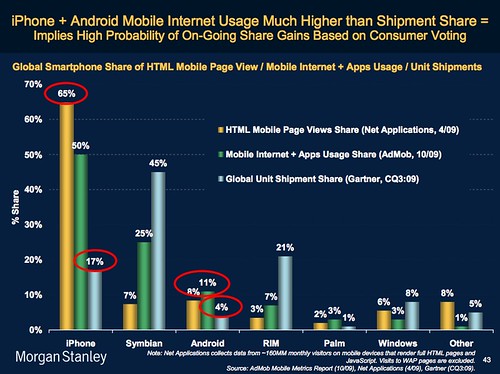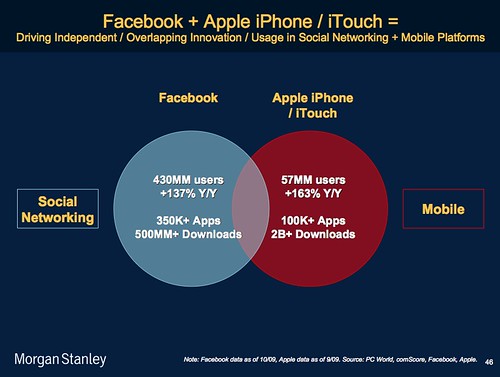In my previous post, I discussed the rumors from USA Today that Apple was in talks with Verizon about making either a CDMA or a 4G iPhone with them. Today, the news has continued, but this time the source is Businessweek.
The rumors seem to have taken on a life of their own with multiple reports that the companies are planning to work together as early as 2010. Businessweek provides the most intriguing report yet with claims that Apple could be working on releasing two different devices with Verizon: an iPhone Lite and a Media Pad.
One device is a smaller, less expensive calling device described by a person who has seen it as an "iPhone lite." The other is a media pad that would let users listen to music, view photos, and watch high-definition videos, the person says. It would place calls over a Wi-Fi connection. One of these devices may be introduced as early as this summer, one person says.
BusinessWeek was able to confirm with Verizon Wireless CEO Lowell McAdam that Verzion had been in talks with Apple but could not get any details from McAdam.
Instead, the magazine cites "two people familiar with the subject" as the source for these two possible Apple devices. The Apple media pad is said to be smaller than Amazon's Kindle ebook reader but its touchscreen is bigger than the Kindle's. The source predicts that this new product will be a category defining breakthrough device:
"The media pad category might go to Verizon," said the person who has seen the device. "We are talking about a device where people will say, 'Damn, why didn't we do this?' Apple is probably going to define the damn category."
Meanwhile, the iPhone Lite is said to be thinner, smaller, and cheaper than the current iPhone. Most of the cost savings are said to come from a new system-on-chip that has reduced costs.
The Businessweek Article in its entirety:
New Gear from Apple and Verizon Wireless?
The companies are in talks to develop two iPhone-like handhelds that could be unveiled as soon as this year
By Spencer E. Ante and Arik Hesseldahl
Verizon Wireless is warming to the idea of an Apple (AAPL) partnership. Verizon Wireless is in talks with Apple to distribute two new iPhone-like devices, BusinessWeek has learned. Apple has created prototypes of the devices, and discussions reaching back a half-year have involved Apple CEO Steve Jobs, according to two people familiar with the matter.
One device is a smaller, less expensive calling device described by a person who has seen it as an "iPhone lite." The other is a media pad that would let users listen to music, view photos, and watch high-definition videos, the person says. It would place calls over a Wi-Fi connection. One of these devices may be introduced as early as this summer, one person says.
Until now, AT&T (T) has been the only carrier of Apple's iPhone in the U.S., adding more than 7 million subscribers as a result of the arrangement; the company has said it's in talks with Apple to extend the partnership, due to end as soon as next year. An agreement to distribute Apple communication devices via Verizon Wireless may cost AT&T some of the business it has gained as the sole Apple carrier. Even if Verizon Wireless and Apple fail to strike a deal, talks between them increase pressure on AT&T to accept partnership terms favorable to Apple.
A Turnabout for Verizon Wireless
In a recent interview with BusinessWeek, Verizon Wireless CEO Lowell McAdam confirmed that the company has spoken with Apple executives. "In the last six months, I have talked to Steve Jobs," McAdam says. Although McAdam would not say what the two companies discussed, two people familiar with the subject said talks covered the new smaller iPhone-like device under development. Representatives of Verizon Wireless and Apple declined to comment. AT&T spokesman Mark Siegel says: "We are delighted with the iPhone and our partnership with Apple." The company declined to make an executive available.
The recent round of talks marks a turnabout for Verizon Wireless, which initially balked at becoming the exclusive U.S. distributor of the iPhone. Verizon Wireless, a joint venture of Verizon Communications (VZ) and Vodafone (VOD), chafed at Apple's request early on to take a cut of the phone's monthly service fees and its desire to choose which retailers could sell the phone. Despite the failure of that deal, McAdam says "there is no animosity" between the two companies.
While talks between Verizon Wireless and Apple have heated up recently, no deal is imminent. It's possible both sides may disagree over financial terms, such as how big a subsidy Verizon Wireless might pay for each device or whether to share monthly service revenue with Apple. Another deal breaker could be disagreements over distribution of wireless software applications. Apple is the exclusive provider and distributor of apps for the AT&T iPhone. If Apple requests a similar deal on newer devices, Verizon Wireless may balk.
Whatever the outcome of Apple's discussions with Verizon Wireless, they at least could be used as a bargaining chip to help win concessions from AT&T. Apple may want AT&T to absorb an even larger portion of the costs of manufacturing the phone. Plus, it may seek to obtain promises from AT&T to beef up investments in its network and customer service operations. Many iPhone customers have complained about the quality of AT&T's wireless network. AT&T's success is so tied to the iPhone that it may have little choice but to accede to Apple's demands. Still, during Apple's quarterly earnings call on Apr. 22, Apple Chief Operating Officer Tim Cook said: "We're very happy with the relationship that we have [with AT&T] and do not have a plan to change it."
Potent Threat
Apple could also use the prospect of an iPhone-esque device as leverage to prevent Verizon Wireless from introducing the Palm (PALM) Pre, or at least delay the introduction of the smartphone on Verizon's network. Sprint Nextel (S) is due to release the widely anticipated phone in June. Selling the Pre through Sprint, with 35.5 million subscribers, is less a threat to Apple's iPhone than if Verizon Wireless, with 86.6 million subscribers and a reputation for a superior network, were to begin distributing the device.
USA Today reported on Apr. 27 that Verizon Wireless and Apple are discussing the development of a current version of the iPhone for Verizon Wireless. That would mark the first time Apple has produced a version of the iPhone for a CDMA wireless network, which is different from AT&T's GSM technology.
But analysts say such a deal is unlikely because it would mean Apple would have to develop two versions of the same phone, which would increase the company's costs. "We believe such a deal is unlikely due to the technology hurdles involved in building and supporting its first CDMA iPhone," Gene Munster, a senior analyst at Piper Jaffray (PJC), wrote in a research note. Re-engineering the existing iPhone would also prove challenging from a design point of view, says Richard Doherty, research director of the Envisioneering Group. "You would be throwing away dollars," he says. "Part of the miracle of the iPhone is they have big volumes with the same design."
Terms of the Apple-AT&T agreement haven't been made public, but they very likely impose strict limits on Apple's ability to introduce an iPhone on a rival network. Many analysts speculate Apple and AT&T will extend their agreement in some fashion.
Smaller Media Pad
The new Apple devices under development, if introduced, hold the potential to shake up the tech industry. The media pad is smaller than an Amazon (AMZN) Kindle electronic reader, but its touchscreen is bigger than the Kindle's, says the person who has seen it. Carriers such as Verizon and AT&T are keen on striking deals to supply wireless Internet access to these new small computing devices, such as netbooks, which represent revenue growth opportunities. Phone carriers also fear being cut out of their core markets for supplying land-line and wireless voice services.
"The media pad category might go to Verizon," said the person who has seen the device. "We are talking about a device where people will say, 'Damn, why didn't we do this?' Apple is probably going to define the damn category."
The new iPhone-like device is slightly thinner and smaller than the existing iPhone, people say. The reason the device is much cheaper than existing iPhones is that it relies on a so-called system on a chip, which incorporates many types of chips and drives down the cost of silicon in such devices, says one source familiar with the design. This new chip could also potentially be used in the media pad. "It will have a much lower cost that will blow away the margins on the BlackBerry and the iPhone," the person says.







